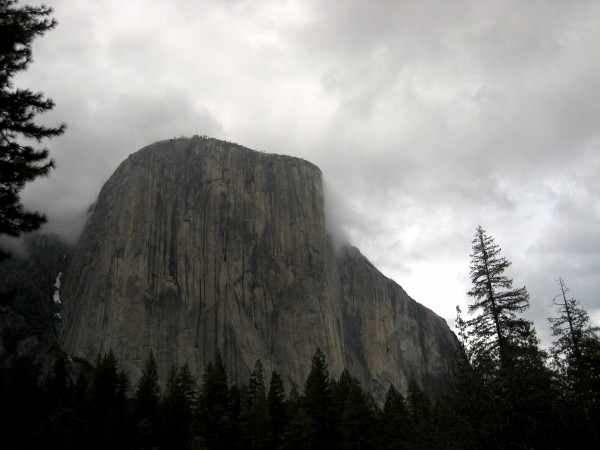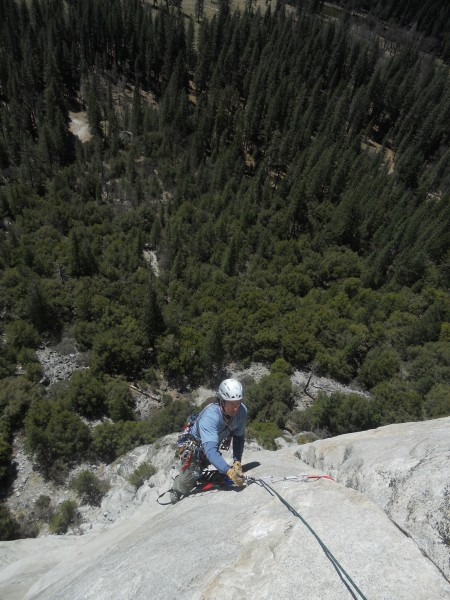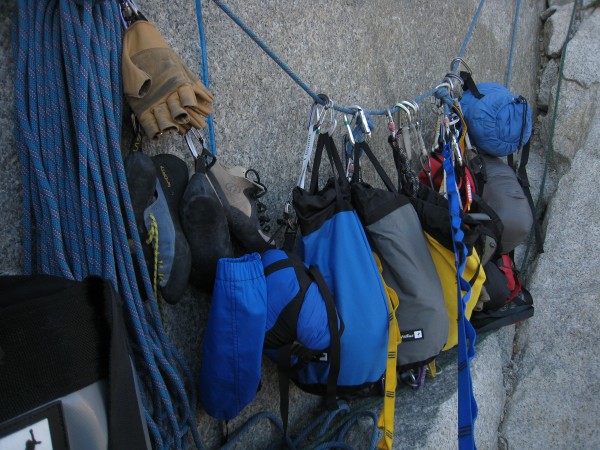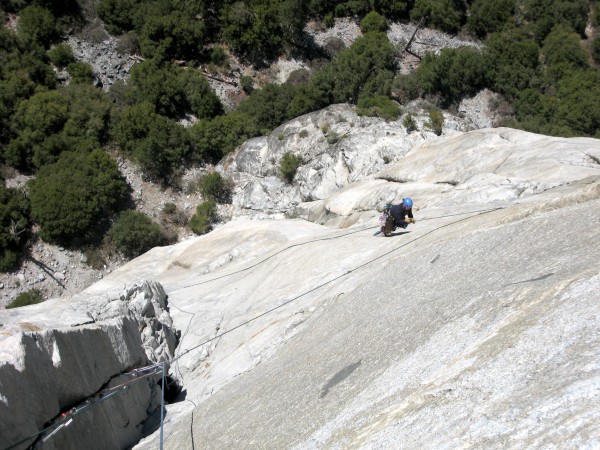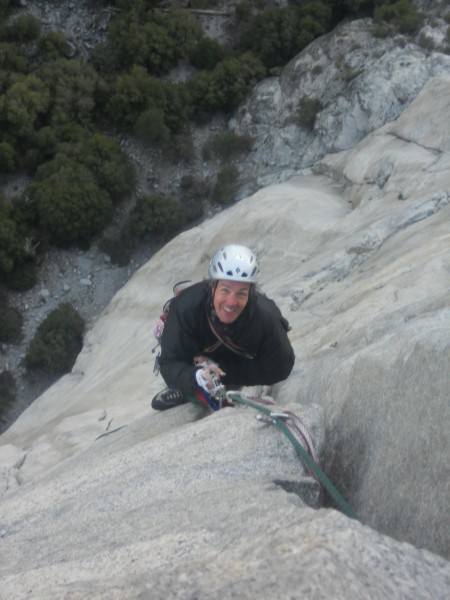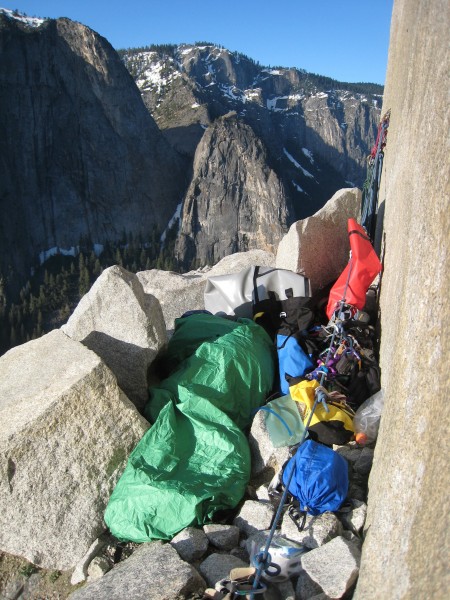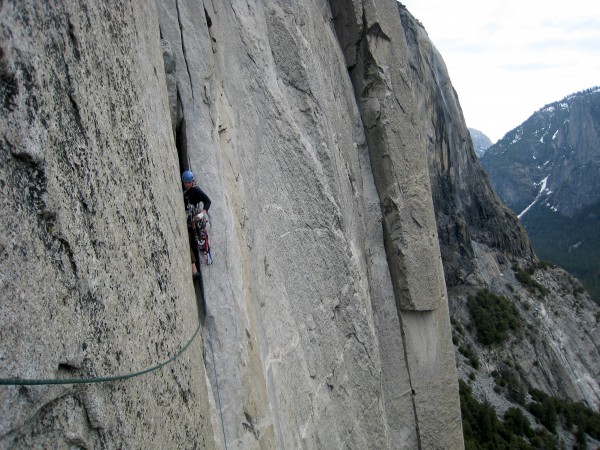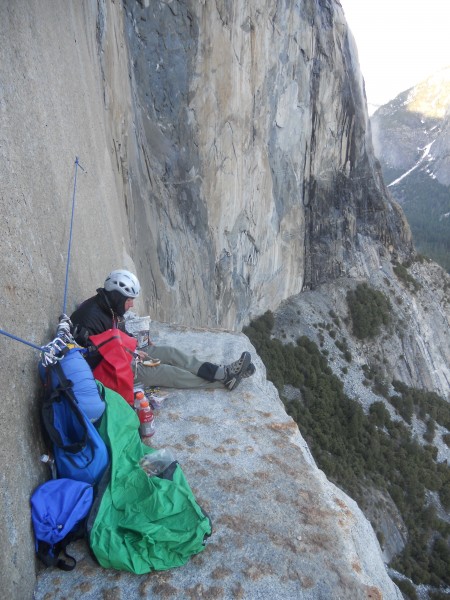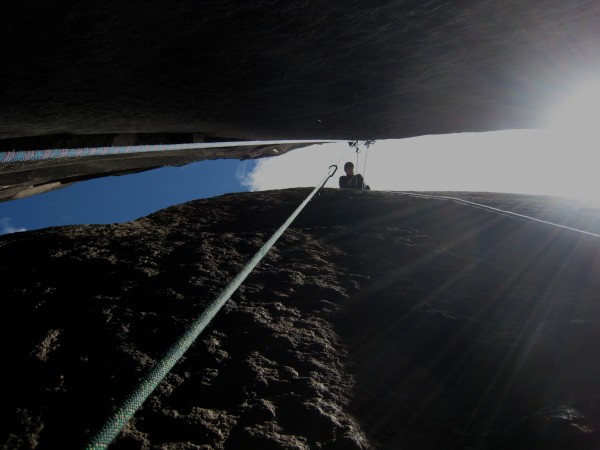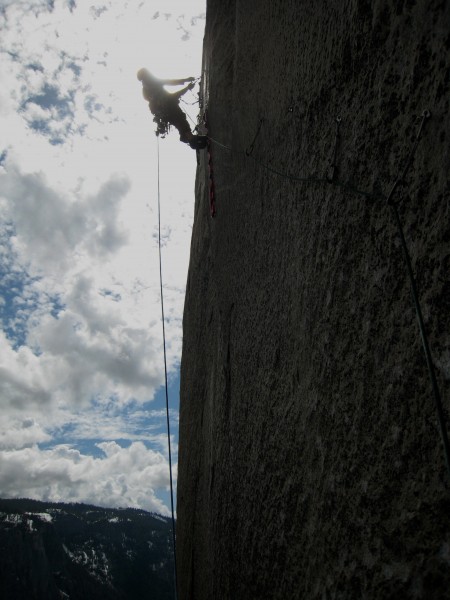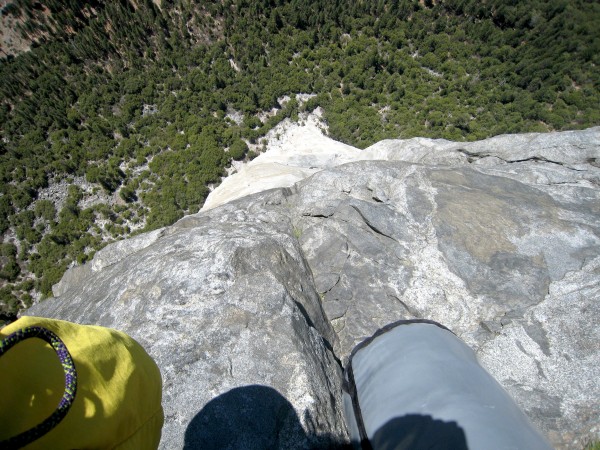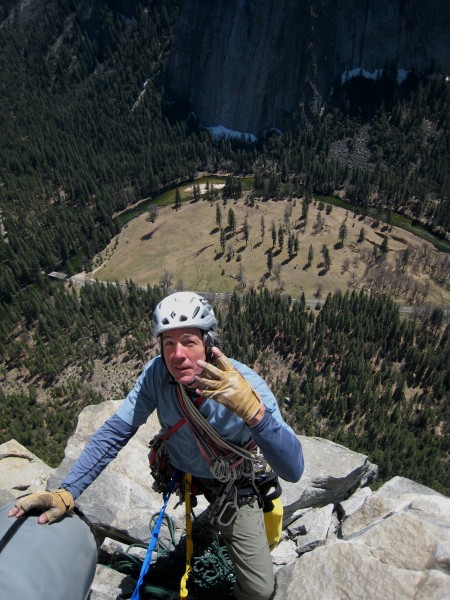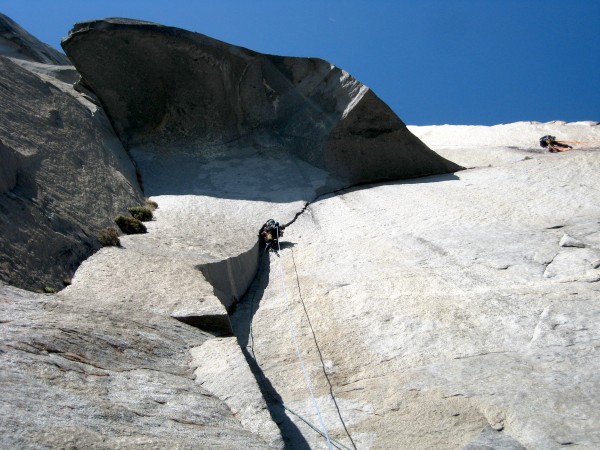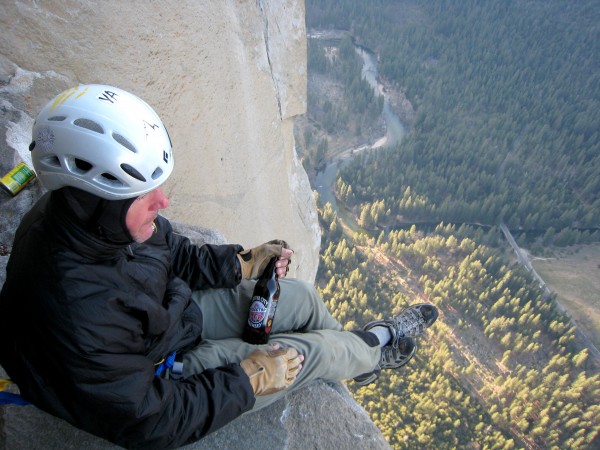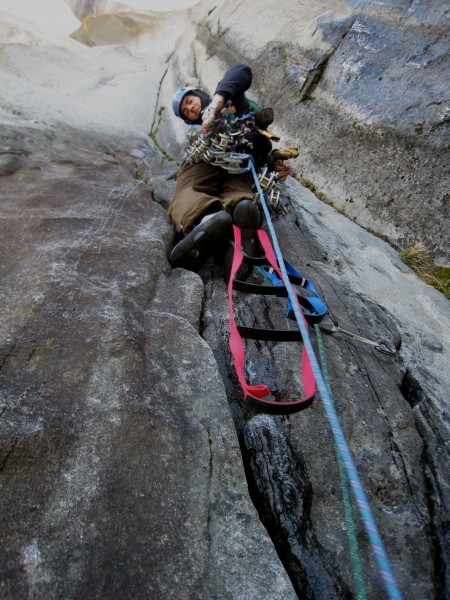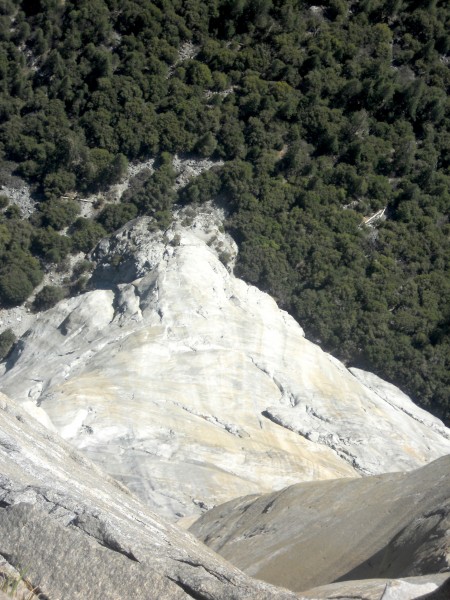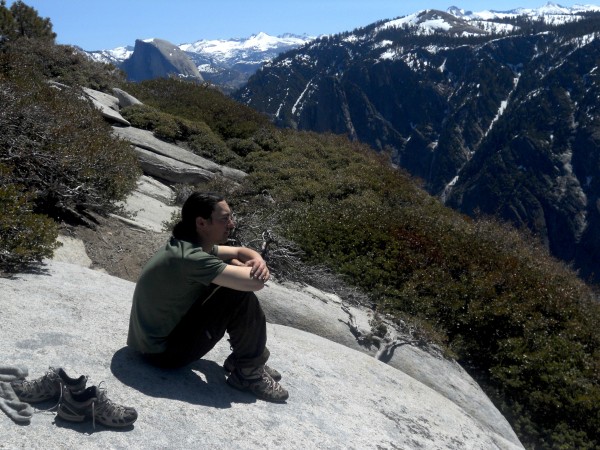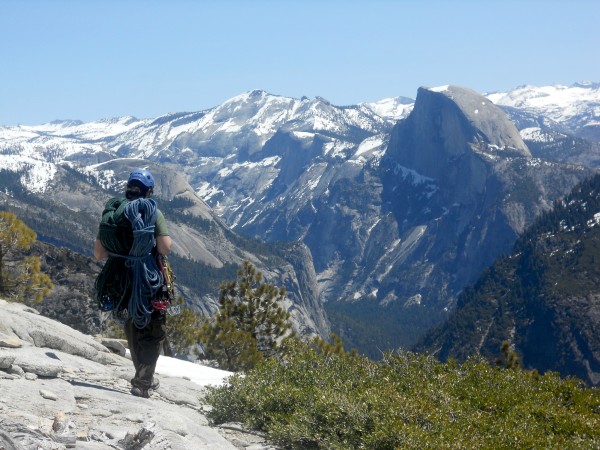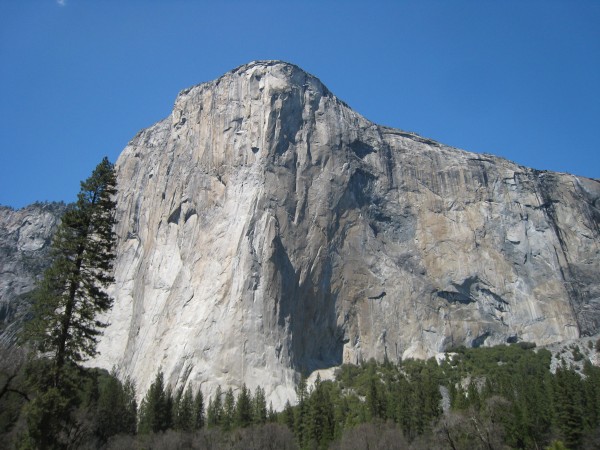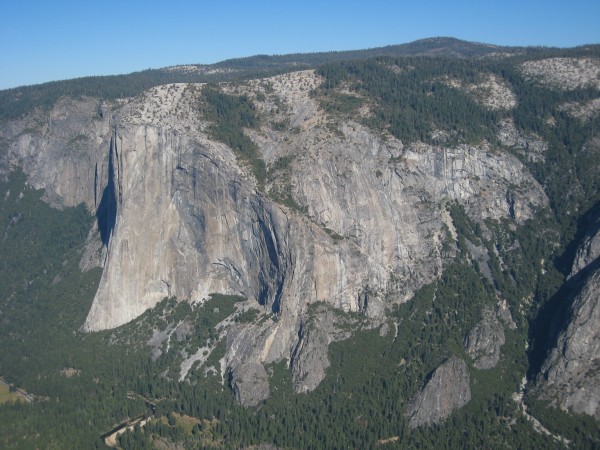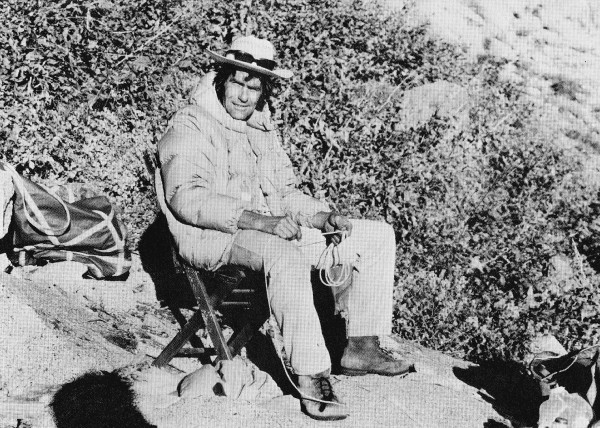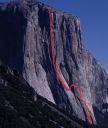Several days before we had arrived in the valley and were stunned by the lack of climbers. Camp 4 was, at most, 20% occupied and to walk through it you had to play hopscotch to dodge the puddles and ponds. The winter of 2010-2011 had been a heavy one and all the high country roads were still closed. Water was pouring from the valley walls in all kinds of places where I’d never seen it before. The skies were gray and wet but were supposed to clear in a couple days. One pair from the UK had bags on Sickle and they were poised to blast their fixed ropes as soon as the weather cleared. We prepped our gear and watched the forecast.
On Tuesday the 26th, we woke early and grunted our gear to the base of Pine Line. The air was clear, the rock dry, the sun warm, and the anticipation was full-on but I wouldn’t say we were nervous. What a great way to start out. Unlike the method that is now fairly standard practice, we were hauling as we worked our way up the first few pitches to Sickle. We were delayed a bit by a day party that was planning to climb as many pitches as they could manage, but we soon found ourselves alone when they rapped off after deciding they didn’t have the right pro for the third pitch.
Despite having heard the various warnings about hauling the first pitches up to Sickle, we’d long ago decided that once we were on the wall, we did not want to come down. So we nixed the conventional concept of spending the first night on the ground after pre-fixing to Sickle. We liked the idea of being on the wall for keeps, even though it may have lacked somewhat in efficiency. After all, we were here to wall climb.
Given all of that, we still made pretty good time to Sickle, but it was apparent we would not make the next seven pitches to Dolt Tower that day. Having no portaledge (by choice), we were committed to reaching real ledges each night. We liked that idea, too. So we enjoyed the leisure of the afternoon and fixed to the belay out on the face past the top end of Sickle (belay 6). (By the way, Hans and those guys clearly have a magic 60 meter line, because there’s no way 60 meters comes anywhere close to reaching that belay to within 10 or 20 feet, but the 4th class that the second would have to cover to make it reach is no big deal. Our lead line was 70 meters.)
Through the pleasant afternoon and into the chilly breezy evening, we watched the UK guys who had jugged to Sickle that morning do battle with the Stovelegs pitches. It looked like slow, cold going, despite the fact that at least one of them had a full alpine-type shell suit.
We’d heard the doom and gloom about the inhospitable Sickle bivy, but it wasn’t awful. One down side was that at least half of it was seriously sloping, so I had to keep tension between the anchor and my harness all night. I woke frequently to wiggle and adjust everything to keep the circulation going. So what? We were bivying on the Nose! Far better than the valley or some lodge room. Plus Harding and all the others had passed here before us. Some at breathless speed, others snail-like, and everything in between. And all it cost was the effort to get here.
Back in ’57 and ’58, Warren G. Harding and his crew had scrawled messages on bits of paper, encapsulated them in spent tin cans, and jettisoned them down the wall to their friends on the ground below. Our means of communication was hardly as reliable. In the 30+ years since Batso Harding, including landing on the moon, proliferation of GPS and weather satellites, and the worldwide explosion of game consoles, iPods, camming devices, and Coca-Cola, we still had only spotty cell phone service. So each night we sent out one brief text message stating our status. This night it simply read, “On Sickle Ledge for the night.”
In the morning we lit out for Dolt Tower or El Cap Tower, whichever the day and our speed allowed. As the morning passed it became clear to me why so many parties bail after the section between Sickle and the Stovelegs. Three consecutive hanging belays with two big lower outs for both the follower and the haul bag make for an early rude awakening for parties unaccustomed to these complexities. The rudeness is probably compounded if they’d previously only hauled the relatively straightforward haul up the fixed-rope shortcut to Sickle.
At Dolt Hole we chose the bolt ladder path followed by the pendulum to reach the Stovelegs. The pendulum from the top of the bolt ladder to the Legs was bigger than expected (everyone, including us, is always preoccupied with the King Swing), not to mention exciting and even fun! The leap over the knee-high Dolt corner makes it fairly athletic too. The thrill of this swing is capped off perfectly with the elation that comes from latching the textbook Stovelegs hand crack just as the swing loses its last ounce of momentum. And then once you pull into it, the jams just put a smile on your face. That thing is splendid.
The first belay in the Stovelegs (7 ½ or 8 depending on your topo) is the only one on the route that I can recall that was not fully equipped. There was a single bolt at the dogleg in the crack and no piton. The rest of the anchor was hand sized cams to anchor everything and haul from, so you’re hoping you leave enough cams free for the long crack lead on the next pitch.
Here we made our solitary hauling blunder for the climb. I got lines crossed during the pendulum and Jason had to clear the mess as he came over to the belay. At this last of three-in-a-row hanging belays we sorted things out and Jason set off up the rest of the Stovelegs. The pitches on this section were steeper and more sustained than I expected. We both agreed later that Chris Mac’s publicity about climbing the route with a minimal rack, and Han’s comments ala “Consider two #4’s if you really suck at offwidths” misrepresent what most climbers would feel is reasonable here. We carried two #4 Camalots and a #5 Friend, and we were glad to have them. Certainly those with ninja Yosemite 5.11 crack skills will be satisfied with less, but not most people. For a long pitch where you wait and wait to place that large cam, and then start walking a second one, is that second one enough, or would you wish for a third? Or even a fifth!?
During the afternoon, a choice developed. Get to Dolt Tower comfortably, or press on in the dark to El Cap Tower? The problem with the latter option was that we were determined to go from El Cap Tower to Camp 5 in a single 10-pitch day. We were hard-nosed about skipping Camp 4 so we wouldn’t have to settle for the inferior bivy there and perhaps miss out on the classic Camp 5 spot. The decision was made to bivy at Dolt Tower, and then take a short day to El Cap Tower so we’d be fully ready to blast for Camp 5 on the following day.
The Dolt Tower bivy turned out to be the roomiest and most secure on the route. There was room to spread out and set things down without too much worry of them rolling off into space. We enjoyed the evening from the elevation of our new bivy and took in the sights and sounds of the valley below and the sublime wispiness of the surging Horsetail Falls way out across the expanse of the SE face. A few hundred feet above, a pair of legs dangled over the top of Boot Flake. The UK pair apparently stopped on that tiny spot for the night. At the end of the day we texted: “Safe on Dolt Tower.”
In the morning we enjoyed spacious Dolt Tower and got the bag packed. Jason then led the three pitches to El Cap Tower where we marveled at the perfectly flat rectangular El Cap Tower ledge. Really cool, but keep everything tethered here. There’s no lip on this ledge to save any sleeping bag or piece of gear that finds its way to the edge.
We watched the UK guys above negotiate the King Swing to reach the Nose rap route. Then they began the long series of rappels off the route. They had run out of time. We shouted a few greetings back and forth when they reached the rap station out to the left of the Tower. Soon they rappelled out of sight and we were the only ones on the whole route. We'd hoped we would get to experience the feeling of being alone up there, now here it was, and it actually increased the joy we felt at being in this amazing place.
With most of the day still at our disposal, we carefully mapped out what we would do next. It would be unconventional, but it could save considerable time on the big El Cap Tower to Camp 5 day. Here’s what we did: Jason led to the top of Texas flake where we fixed the haul line. Next he went to the top of Boot Flake and rigged our 70-meter lead line like a top rope through the Boot anchors and down to the Texas anchors. Then we retreated to El Cap Tower for the night.
Here we came to the simultaneous realization that we should and could no longer delay the inevitable. Out came the wag bags that we’d brought expressly for this purpose and we took turns filling them and handing each other the TP. We were the only ones on the Nose now and a throng of watchers had clearly gathered in El Cap Meadow below. We didn’t know the resolving power of their binoculars, but if they were lucky they witnessed one of the heartwarming cooperative moments of big wall partner-hood with the bonus of learning the answer to the timeless question: “How do they go number two up there?" At least we didn’t have to hold the bags for each other, and to the best of our knowledge, we have yet to become YouTube celebrities.
The topo says “El Cap Tower, plush bivy for 4-6”. Six would definitely be crowded, but today that would not be an issue. We were the only party on the route.
Early the next morning we packed the bag with anticipation. This was to be our big day, the crux for us. Our aim was to cover the ten pitches to Camp 5 including the King Swing and the Grey Bands without time-consuming glitches. Based on our times per pitch so far, we calculated we should be able to get there well before dark. We were fastest and most efficient with Jason leading, so we decided that he’d stay in the lead for the whole day.
As we finished getting ready, we heard voices as two Nose-in-a-day parties climbed towards us from Dolt Tower. One climbed directly towards us, so they were going to take the King Swing path. The others diverted to the Jardine Traverse variation. We allowed the first pair to pass us at Boot Flake and we lost some time waiting there.
Then Jason and I tied into our pre-placed Boot Flake top rope and Jason pulled off the King Swing in three or four swings. I lowered out the bag to Eagle Ledge and followed the Swing with assist from the hauling tag line. Next we crossed our fingers and pulled the King Swing top rope. If it had somehow gotten stuck on the pull, we would have peed our pants first and then figured how to deal with it second. It pulled cleanly. Our pants were spared.
At Eagle Ledge we waited again for the first NIAD team leader to finish his lead. The leader on the second team approached our belay from below. The opening exchange was right out of Hans’ “How NIAD parties can win friends and influence people to let them pass” playbook. It was so scripted that it was almost pitiful.
1. Smile.
2. Smile and ask, “How’s it going? Great climb, eh?”
3. Smile. “Where’re you from? How about this weather?”
Ready. Wait for it.
4. With the words all run together: “Saywe’retryingtodothisinaday.Doyouthinkwecould pass?Wewon’tholdyouup.”
We offered that they could take the left hand variation at 18-19 and we’d take the right side and the deal was sealed.
Our turn: “Where are you guys camped in the valley so we can pay you a visit if you delay us and keep us from reaching Camp 5?”
Even with the hauling and the haul bag lower out at 19-20, Jason kept us on their tail. We continued to wait at each belay all the way until the belay after the Great Roof.
The Camp 4 “ledge system” was passed in the early afternoon and we concluded that, yes, we did not want to bivy there and we were moving well enough to make Camp 5. The Great Roof was right above us now and between the leading and cleaning, this pitch took the most time of any to put behind us. The crack at the back of the roof was oozing with green slime, but still negotiable. Again, there was less fixed gear than we expected.
From the belay at the end of the Great Roof, Pancake Flake and the upper dihedrals all soar almost straight up above you and the massive shoulder that dominates the lower part of the Nose buttress sweeps below all the way to the first pitches and the ground. It’s an incredible, beautiful spot, and you’re right in the heart of Golden Age Yosemite history. Two more pitches to Camp 5. We would make it.
Pancake Flake looked free-able, but not in-total with all the wall gear. Too bad, too. We were counting on it being a nice free pitch for us. And the bolts shown on the topo? Not there. It was gear placements all the way.
Jason led into Camp 5 and I followed as quickly as I could. Headlamps were switched on as we got the bivy arranged and this was one amazing perch. We set up on the middle ledge marked “good bivy for 1, ok bivy for 2”, and I’d say that’s accurate. The only way two could fit was to lay diagonally with each person angled toward space and feet at the edge of the ledge, or slightly over. We tied in tight.
If Dolt Tower is the camper’s bivy, then Camp 5 is the hero bivy – just adequate in size and situated on the buttress with dihedrals steep above and air, lots of gaping air, between our feet and the toe of the great south buttress. What a place to wake up!
I don’t remember much about our conversation on that bivy. I expect we marveled at it and laughed about its improbability. We figured we would have reached it at least an hour, maybe two, earlier had we not been held up at Boot and through the Gray Bands. But we didn’t complain. We were pleased with our efficiency and, except for the group on day 1, today’s NIAD’ers were the only people we’d been close to on the wall. Our plan to climb early in the season, some might say even pre-season, had paid off in this regard, but we could have used a little more warmth most of the time. As we felt grateful for our sleeping bags, bivy sacks, and insulated jackets, we pitied the two NIAD parties we heard toiling above us in the cold and dark well into the night. They had to be suffering. Our electronic sardine can message to the world read: “At Camp 5. 7 pitches to go. Jason is busting it out."
Throughout the night, ice pellets from somewhere above pitter-pattered on our bivy sacks. Nothing dangerous but it reinforced that temps were in the freezing zone. In the morning we shivered as we loaded up. It would be hours before the sun came around the corner to warm our bones. My thoughts flashed to Harding, Hill, and others before us as we ascended the shaded corners past the Glowering Spot and on to Camp 6. Hot coffee probably also entered my mind. Here, even at mid-morning, we faced 15 feet of ice at the start of the Changing Corners pitch. We laughed that the situation called for bounce testing otherwise perfect placements just to get the cam lobes to break through the ice.
I don't recall when, or exactly why, but we decided Jason would continue to lead through this day, as well. Even though we both honed our leader and second roles to where this arrangement was the fastest way for us to progress, we figured we would probably switch at some point since today we only had to cover seven pitches to reach the top. Maybe we held off because we encountered a couple unexpected hanging belays in this section that would have made a switchover too clumsy.
The sun finally reached us at belay 27, a hanging belay on a vertical smooth face split by a thin crack. Pitch 27? Crazy. We had really covered twenty-seven pitches up this incredible route!
I do not remember much at all about pitch 28, but 29 held a couple of minor aid tricks for the leader and second as it led us into the sun once again at the wild stance. At this half-a-stair-step sized footrest you're shoulder to shoulder sorting gear, flaking rope, and marveling at the surroundings. It's all there. Middle Cathedral and the rest of the Cathedrals are below now and you feel like you've poked your head up out of the valley into the snow covered high country. I wished we could just hang out here for a few hours. El Cap Meadow seems like it's beneath your butt as you lean back on the anchors, and there, just above, are the audacious summit overhangs and Warren's landmark bolt ladder.
For him it was a means to realize his incredible vision and cross the gap from his outrageous vertical voyage back to the world of men. It did, and does, fill that role, but for me it also connected 1958 to 2011; prussik slings to ascenders, twisted rope to kernmantle, and stove leg pitons to cams. The man who believed that a route could be found up the proudest line on El Cap is gone now. But that bolt ladder is a lasting testament to his drive and perhaps it’s fitting that it comes on the last rope length of the climb. In all kinds of places on the Nose you find yourself wondering what it must have been like to cast off on this imposing cliff back in '57, and that last pitch is no exception. In fact, you have no choice but to recall the tale of Harding's magnificent night-long bolting effort and to pause right there, at the last step, and tip your hat.
From that small stance you can also see the afternoon sun on the branches of the little pine trees rooted above near the edge of the summit slabs. You realize it's almost over and you really don't want it to be, but this is the fifth day and it's time to be done.
Jason linked pitch 30 and 31 and belayed right where the wall rolls into the summit slab. I followed on aiders and it sounded like some people were whooping down in El Cap Meadow. We dragged the bag up the last little slab to the famous tree and, strangely, were stymied for a minute wondering how we would negotiate the horizontal ground that separated us from a potential bivy site across the way. If it had been vertical, we would have hauled it, the same as we had for the last few days.
In the afternoon light we stripped ourselves of the gear we'd had attached to ourselves for days. Stretching out on flat ground without having to anchor everything was marvelous. Could there be any greater luxury? Yes, there was. A beer for each of us and a can of beans that may or may not have been warmed over a small crackly fire - the first warm food since the valley. Our last tin can message: "Summit! It goes! More to follow."
The day ended too soon, and sleep came too early. Next thing, it was morning, so we sat, sun warmed, on the summit slabs and absorbed the high country panorama with the green valley below that was only now awakening into a late-arriving spring. Fingers and slabs of snow still reached up into gullies and onto the walls of the Cathedrals.
We finally faced the harsh reality that we had to carry everything down to the other world. The top-heavy haul bag had a mind of its own on the walk across the slabs to the East Ledges rappels. The obstinate bag, in combination with the running water and snow patches, made the whole endeavor less of a stroll and more than a chore. Jason continued to endure a rope burn at his harness line that came from a NIAD tag line at the King Swing. Despite it, he carried most of the hardware and two ropes for hours on the descent.
The East Ledges rappels demanded some logistics, but at least we didn't have to bodily carry everything down them. Then upon reaching the bottom, we saddled it all up again and made our way down the last section of path as it transitioned from rugged to civilized with each step toward the valley. The sun slanted through the oaks, the air grew warmer, the footing improved. As the ground flattened we tidied up our appearance as we walked. Surely cheering crowds with pitchers of iced drinks would appear at any moment to take up our loads and usher us to a waiting picnic spread. Instead, we emerged from the forest into the Manure Pile picnic area where a handful of clean, well-supplied picnickers were only distracted for a moment as they wondered why anyone would step from the woods with such huge bundles and why they would bodily carry them rather than simply transporting them there by car as they had.
Within a few minutes though, a couple that had just finished cragging at Manure Pile knowingly assessed our situation and offered us a lift to our vehicle at El Cap Meadow. Ahead of us at El Cap bridge, the Astrovan was a welcome sight. Behind us, over our shoulder, we glanced and then turned to take in El Cap at its full height. "There's no way we were on that thing for the last five days." It seemed preposterous, but it had to be true.
Upon completion of his first ascent, Harding was famously quoted as saying, "It was not at all clear to me who was conqueror and who was conquered. I do recall that El Cap was in much better condition than I was". I can identify with that. And I don’t know how many times Jason and I (maybe me more than him) said something like, "What was he thinking when he came up here in '57? What kind of vision and drive did it take to imagine that something like this was possible and then start up it, take it on, and see it through?" It amazes me that, within a few days of missing out on the first ascent of Half Dome, Harding just walked down the valley, looked up at El Cap and concluded that the next logical step was staring back at him and the time was now. No time set aside to train for it. No delays to develop new tools. No reason to work out any new techniques. And the Nose is more than an increment bigger than Half Dome. Its pendulums and logistics are huge compared to Half Dome. The climbing is way more daunting and sustained on the Nose. A salute of admiration to a one-of-a-kind character who leaped over the incremental steps and took the thing straight on.
And isn't that the continuing legacy of this crazy connection of thirty-one rope lengths? When you're on the Nose you marvel at its beauty as you pass the incredibly historic features that you encounter: Sickle, Dolt Hole, the Stovelegs, Dolt Tower, El Cap Tower, Texas, Boot, and the King Swing; the Gray Bands, the Great Roof, Pancake Flake, Camp 5, the Glowering Spot, Camp 6, Changing Corners, the Wild Stance, the summit overhangs, and Harding's through-the-night bolt ladder. Do any pictures come to mind when ticking through that list? But the legacy and chemistry of this route are not limited to the first ascent. You're treading the same ground as all those that accomplished the subsequent great feats and made leaps in their own ways: the historic second ascent, the first NIAD, the free climbing efforts - partial and complete, the speed ascents, and many others including modern-day pilgrims who still take five days to do it. And not just that; yes, you're linked to what came before you, but also to what is yet to be done here. Because you've been here, jammed the same cracks, and felt the same exposure, you’ll identify with the tales you will hear. That's what the Nose is, what it represents: a connection to the continuum of rock climbing development and a collective milestone.
So if you've been up there, one time or twenty times, way to go for putting in the effort and pulling it off. Hopefully it was rewarding and worthwhile. If you haven't, decide if it's for you, get prepared, and then check it out for yourself. It probably won’t make you a better person, because it is, after all, just a rock climb. But it is a marvelous and pivotal rock climb; and, for most of us, it will be one of the greatest climbs we ever do. So, chances are, it will affect the trajectory of your climbing experience like it has inevitably and measurably steered the path of climbing history. And when you realize you’re immersed in the middle of all that, you'll think it's pretty cool.
Now, a few practical notes about the climb.
The weather was cooler than we hoped for, and a bit unstable for a wall climb of that length, but we were fortunate to be there during a decent enough window. It was quite warm for a few days after we got back down to the valley, and we thought that summer had arrived for good. But some crummy weather closed in again after that.
We took the weather gamble because we wanted to avoid the usual crowds on the route. Even though we crossed paths with a few parties, most of the time we felt quite alone and that was another experience we were hoping for, so we felt enduring the cooler temps was worthwhile.
Dates: April 26-30, 2011. Temperatures from park website for the valley: lows 29-36, highs 56-60.
19 liters of water, 4 quarts of Gatorade. Two beers. We had some water left for our night on the summit, but temps were cool.
That's about 50 pounds of liquids.
Gear:
Aliens: Blue, Gray. Two each red, green, yellow.
C4's: Two 0.5, Three 0.75-3, Two 4 (a third #4 might be nice for Stovelegs), One 5 Friend.
C3's: One purple, green, red, yellow. A small gray might be nice to have.
Master cams: Purple, yellow/blue hybrid, yellow/orange hybrid. A smaller hybrid would be good.
Tri cams: pink, red, black (red was used at tricky spot on pitch 4)
One ball nut
Cam hooks: Two each small, medium, large. Only one small and medium needed.
Hooks: Two Black Diamond. These were not needed.
Nuts: Black Diamond micro set. Not needed.
Peenuts set. Barely used.
DMM brass offset. Valuable.
DMM aluminum offset. Valuable.
DMM IMP nuts. Used but not essential.
Wild Country Rocks, 1 and 1/2 sets. One set enough.
Several large DMM Wallnuts. Saved a cam now and then.
Eight draws.
Four tripled shoulder length runners.
Six to eight over shoulder runners.
Two cordelette setups, each with three Attaché-type biners plus two large lockers (one for fixed line one for leader anchor).
ProTraxion with oval locker and binder for closure.
Two Gri-Gri's, two ATC's, two nut tools.
Metolius double gear sling with pocket slings (nice setup for all this gear).
Free biners, regular and locking, three to six each.
Fi-fi biner on short sling rigged into belay loop.
Two sets jugs.
Two sets aiders with daisies.
70-meter lead line, 60-meter haul line (dynamic), 8 mm 120-foot tag line for long lower outs.
River bag-type crap bag with Biffy (WAG) bags. Extra TP necessary. Moist wipes.
Metolius El Cap haul bag (barely big enough, but everything except the two main ropes and most of the hardware fit inside, including the crap bag).
Sleeping bags, pads, bivy sacks, large tent fly, puffy jackets (necessary for April, but could pare down for summer).
This load is about as much as two people can reasonably carry down from the summit in one trip. It's a huge amount to carry to the base of the climb. The best bet is to carry your water into the base and cache it (NPS people probably go ape when they hear that - hey, it's just water) the day before you start. To carry everything else plus the water in one trip is just too much.
Pitch notes.
Pine Line: Can link Pine Line start to Pedestal, but haul from top of Pine Line to Pedestal is blocky and ledgy and requires escort of the heavy bag. Haul to tree then haul to base of actual pitch 1.
Pitches 1-4: Mostly aid. Hauled okay considering the low angle. Red Tri Cam worked at C2+ spot on pitch 4. This is the point where the free team ahead of us bailed because they could not protect the pitch. These pitches diagonal more to the right than indicated by the topo.
Pitches 5-6: Used 70-meter rope to link 5 and 6. Would not link with 60-meter without some simul climbing. Pitch 6 is hanging belay at top of vertical part of Sickle, but out on the open face to the right. Lower bag out and around Sickle outside corner about 50 feet out along the ledge where ledge goes from 4th to 5th class.
Pitch 7: Bolts 15 to 20 feet above belay 6 anchors are the free variation bolts. Probably simpler to not use them and just lower out from belay.
Pitch 8: Took Option A bolt ladder. Two reaches on the bolt ladder were quite long. Wired nut looped over intermediate bolt studs helped. Pendulum to Stovelegs from top of bolt ladder will probably be longer than you expect. Belay at 8 in Stovelegs was one bolt and two cams (#1 and #2). The piton was gone. Rumored bolt station 20 feet higher was not there.
Pitch 9: Be ready to leapfrog cams.
Pitch 10: Be ready for scary leapfrogging. Both #4 cams and the #5 Friend were used. Hold onto #4’s as long as possible and be ready to go a long way before leaving a #4 for pro.
Pitch 11: Used both #4's and the #5.
Pitch 12: Lower out from Dolt Tower. Wide crack to get established at start of pitch. Good place to practice use of 8 mm lower out line.
Pitch 13: Used both #4's.
Pitch 14: Could link with 13.
Pitch 15: Texas Flake. Leave rack in bottom of chimney. Scary chimneying. Anchor bolts are high above top of flake top. Awkward.
Pitch 16: Boot Flake to Eagle Ledge. Hard thin aid just after bolt ladder leading up to Boot. Two cam hooks. Rigged top rope with 70-meter (60 would not do it) as described earlier. Swing as per SuperTopo, i.e. lower to second or third bolt with rope on shin of boot).
Pitch 17: Committing free then aid.
Pitch 18 1/2: Went from Eagle to intermediate belay marked on topo with three bolts. Short pendulum with lower out worked okay.
Pitch 20: Linked across Pitch 19 Gray Band ledges up to pitch 20 belay. Diagonal haul, so used tag line to tend bag. Would be tricky to tend bag across ledges otherwise.
Pitch 21: Wet due to spray from above (April). Free climb.
Pitch 22: Great Roof. Time consuming. Slimy under the roof (April). Step across to belay further than expected. Tricky to clean in a few places.
Pitch 23: Pancake Flake. Steep but free-able. Tough to free it all with wall rack. Bolts shown on topo were not there.
Pitch 24: Mostly aid. Stop at second set of bolts.
Pitch 25: To the Glowering Spot. Now you're up in the dihedrals and it's steep. Felt like C1+.
Pitch 26: To Camp 6. Used two #4's and three #3's. Camp 6 was clean (It was April, also thanks to clean up crews).
Pitch 27: Changing Corners. Hard aid (well, hard for the Nose). Use runners on Changing Corners bolts. Run rope safely. Intermediate belay on topo not seen. Hanging belay at thin crack - two bolts and yellow alien.
Pitch 28: 5.8 and aid. Steep.
Pitch 29: Route moves to right some now. C2 in alcove. Tricky to clean. Wild Stance at top is cool perch but small.
Pitch 30, 31: Linked with a lot of rope drag. Skipped numerous bolts.
Top!: Just a few steps past the last anchor.
There’s been some discussion about limiting bivying on the top. That would be so sad. Why would you want to hurry down to the Valley to camp next to an RV?
Descent: Walk east across the slabs. Follow descriptions for finding and using East Ledges rappels.
If you’ve been up there for a few days, prepare yourself for re-entry into this other world. Hot food, ice cream, and numerous comforts are now just minutes away, and available with almost no effort. Enjoy the contrast while it lasts.
